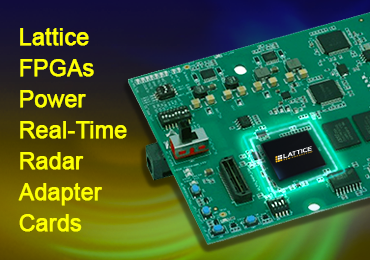This blog post was originally published at Lattice Semiconductor’s website. It is reprinted here with the permission of Lattice Semiconductor.
If you were to ask them (and I have), you would discover that many people think of radar in the context of things like airplanes and ships and the evening weather forecast on TV. As part of this, they tend to think of radar systems as being large, bulky, and expensive.
In fact, using the portion of the electromagnetic spectrum known as the millimeter band in conjunction with modern semiconductor technologies (a.k.a. silicon chips), it’s now possible to implement radar-on-a-chip, which opens the door to a vast array of sensing applications.
mmWave Radar
Extremely high frequency (EHF) is the International Telecommunication Union (ITU) designation for the band of radio frequencies in the electromagnetic spectrum from 30 to 300 gigahertz (GHz). Radio waves in this band have wavelengths from ten to one millimeter, so it is also called the millimeter band and radiation in this band is called millimeter waves (a.k.a. mmWave or MMW).
Due to mmWave radar’s short wavelengths, it can provide high resolution with sub-millimeter accuracy. It’s able to penetrate certain materials such as plastic, drywall, and clothing, and it is impervious to environmental conditions such as rain, fog, dust, and snow.
A complete mmWave radar system includes radio frequency (RF) components to transmit (TX) and receive (RX) the millimeter radio waves, analog components to implement functions such as clocking, mixed-signal components such as digital-to-analog converters (DACs), and digital components such as digital signal processors (DSPs). Traditionally, mmWave radars were implemented using discrete components, which increased the size, power consumption, and cost of the system. More recently, technology-leading companies like Texas Instruments (TI) have created complete mmWave radar systems on a single complementary metal-oxide semiconductor (CMOS)-based chip.
Automobiles and Robots and Surveillance, Oh My!
The small size, low power consumption, high-resolution, sub-millimeter range accuracy, and affordable nature of mmWave radar systems makes them attractive for a wide range of applications. Such applications include, but are not limited to, the following:
- Building Automation: Detecting and tracking people and animals inside and outside the building.
- Safety Guards: The position and velocity of people can be used to trigger safety systems when a person or an object comes too close to a dangerous machine in an industrial setting.
- Level Detection: Monitoring the levels of fluids or solids in tanks or silos.
- Traffic Monitoring: Detecting traffic, pedestrians, bicycle riders, and animals in all light and weather conditions for intelligent decision making, data logging, and reporting.
- Robotics: Equipping fixed robots with the ability to detect people or objects in close proximity, and autonomous robots with the ability to detect people or objects and use this information to make intelligent decisions.
- Automotive: Detecting other traffic, pedestrians, bicycle riders, animals, and obstacles in all light and weather conditions for intelligent decision making. Also detecting and monitoring occupants (adults, children, pets) inside a car for applications such as child presence detection, seat belt reminders, and more.
In addition to the sensor devices themselves, TI also supplies a range of automotive (AWR) and industrial (IWR) mmWave radar evaluation modules (EVMs).
No Sensor is an Island
The saying, “No man is an island entire of itself; every man is a piece of the continent, a part of the main…” comes from a sermon given by the seventeenth-century English poet, scholar, soldier and secretary John Donne. By some strange quirk of fate, the same thing applies to radar modules. Impressive as they may be, they require the ability to communicate with the outside world to make them whole.
The high-speed raw data received from the radar module requires pre-processing, and the results of which must then be sent in real-time over a Gigabit Ethernet connection to provide system designers and OEMs with the ability to quickly and easily implement commonly-used embedded and smart vision applications (image processing, obstacle detection, etc.) in automotive, industrial, and other applications.
The folks at Mistral Solutions created a real-time data-capture adapter called the DCA1000EVM for use with TI’s EVMs.
The DCA1000EVM real-time data-capture adapter (Image source: Mistral Solutions)
The DCA1000EVM provides real-time data capture and streaming for LVDS and radar data across a Gigabit Ethernet connection over the network to a host PC (the data-capture can process both raw sensor data and headerized, multimode data).
FPGAs Ahoy!
If you look closely at the image above, you will see an FPGA from Lattice Semiconductor at the heart of the system. In this case, the designers at Mistral opted to use Lattice’s low-power ECP5-5G FPGA, which is optimized to deliver high-performance in a small form factor. The ECP5-5G’s enhanced DSP architecture, high-speed SERDES (Serializer/Deserializer), and high-speed source synchronous input/outputs (I/Os) make this an ideal solution for high-performance applications where data latency must be avoided.
In the case of the DCA1000EVM, the ECP5-5G supports the high-speed capture of data from the radar modules over an LVDS interface and provides an Ethernet MAC with UDP support and a Gigabit Ethernet MAC. In future implementations, the ECP5-5G could also be used to perform additional tasks, such as sensor fusion, and implement additional capabilities, such as artificial intelligence (AI)/machine learning (ML) applications at the edge.
We truly do live in exciting times. I must admit that I can think of several things I could do with an AWR EVM coupled with the real-time data-capture and Gigabit Ethernet provided by the DCA1000EVM here in my office. If I were placed in charge of a factory, I would let my imagination run wild and free. How about you? What might you be tempted to do with an mmWave radar?
Kambiz Khalilian
Director of Strategic Alliances, Lattice Semiconductor



